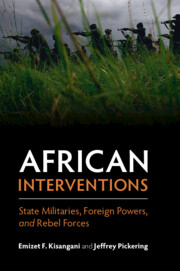Book contents
- African Interventions
- African Interventions
- Copyright page
- Dedication
- Contents
- Figures
- Tables
- Acknowledgments
- Abbreviations
- 1 Context and Issues of International Military Intervention
- 2 Non-colonial Military Interventions in Africa
- 3 Military Intervention by Former Colonial Powers in Africa
- 4 Intra-African Hostile Military Intervention
- 5 Intra-African Supportive Military Intervention
- 6 African Intervention into Failed States
- Conclusion
- Appendices
- Notes
- References
- Index
- References
References
Published online by Cambridge University Press: 29 October 2021
- African Interventions
- African Interventions
- Copyright page
- Dedication
- Contents
- Figures
- Tables
- Acknowledgments
- Abbreviations
- 1 Context and Issues of International Military Intervention
- 2 Non-colonial Military Interventions in Africa
- 3 Military Intervention by Former Colonial Powers in Africa
- 4 Intra-African Hostile Military Intervention
- 5 Intra-African Supportive Military Intervention
- 6 African Intervention into Failed States
- Conclusion
- Appendices
- Notes
- References
- Index
- References
Summary

- Type
- Chapter
- Information
- African InterventionsState Militaries, Foreign Powers, and Rebel Forces, pp. 291 - 309Publisher: Cambridge University PressPrint publication year: 2021

